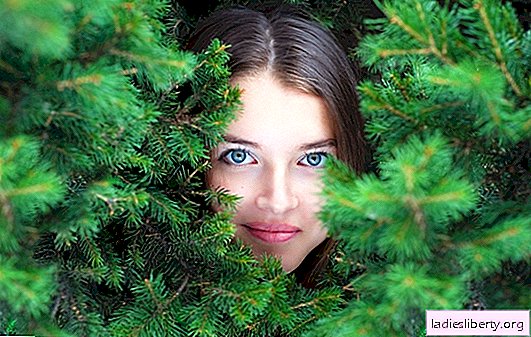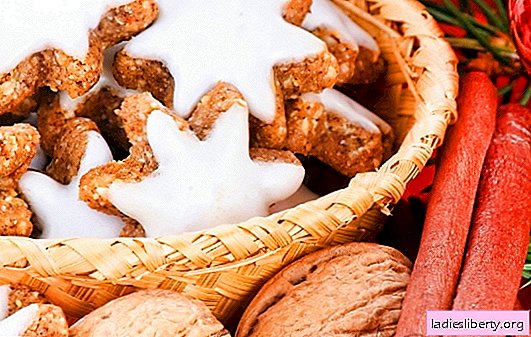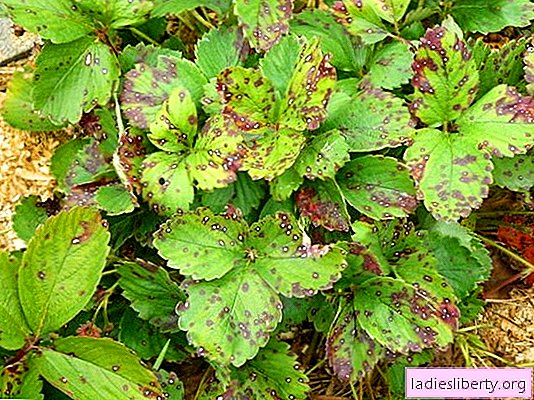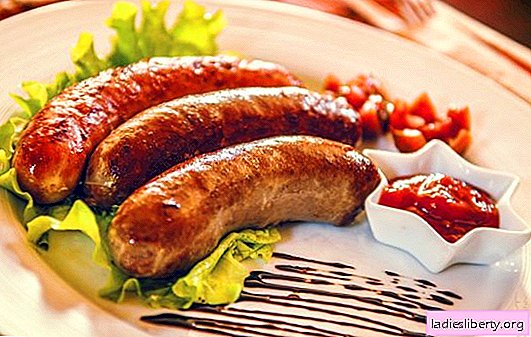
Not every amateur summer resident “dares” to grow a decorative spruce on his plot.
This is not an easy task, because conifers need special care, and even waiting for them to grow and decorate a garden will have a single year.
Spruce will be a real find for those who live in northern latitudes - almost all of its species are not afraid of severe frosts and cloudy days.
You can grow a tree with seeds, cuttings and seedlings.
What grade to choose for cultivation?
A lot of varieties of spruce have been developed that are suitable for growing in any climatic zone. When choosing a particular type, focus on the maximum size of the tree and its decorative properties. If the site is small, you should not grow tall varieties - spruce, when it grows up, will occupy the entire site. Low fir trees are more suitable for decorative plantings - there are a lot of them.
We list the suitable types of fir trees suitable for private cultivation in a summer cottage:
• European spruce (ordinary). With proper care, the tree is drawn up to 30 m in length. The diameter of the needles can reach 5 m. There are varieties that are much smaller in size (up to 8 m), and even dwarf (no more than 1 m). Representatives of this type are more suitable for creating hedges. They easily endure severe frosts and lack of light. Beautiful ornamental varieties of European spruce - Inversa, Acrocona, Kolumnaris, Kompakta, Gregoriana, Elegance, Nana, Clan-brassiliana, Maxwellii, Ekhiniformis
• Spruce spiny (blue). Very popular in landscaping plots. The tree has a pyramidal shape, sharp needles 2-3 cm long, can be extended up to 25 m in height. Representatives of this species love the light, extremely winter-hardy. Pay attention to the following varieties of prickly spruce - Glauca, Iseli Fastigiata, Hoopsii
• Serbian spruce (Balkan). Trees with a low-crown grow to 30 m in length. They grow well in the shade and endure drought. As they grow, shoots of new growth in the form of fringe begin to hang from the branches - very original. Popular decorative varieties are Pendula Bruns, Karel, Gnom.
• Canadian spruce (gray, white). The most winter-hardy, undemanding to soils and early appearance. In nature, reaches a height of 30 m. To date, many low-growing decorative varieties are bred - Conica, Albertiana, Pendula, Fastigitata, Alberta Globe
• Siberian spruce. Representatives of the species are adapted to the harsh northern conditions. Cone-shaped crown of a tree and dark green needles will decorate any site. Of all the ornamental varieties, Glauca is popular.
• Spruce Tien Shan. Coniferous tree with a narrow crown originally from China. The ends of the branches are drooping, with needles up to 4 cm long. Spruce loves high humidity and plenty of light. The decorative variety Globosa is popular in our country.
Where to plant a spruce?
If possible, take under the cultivation of spruce. sunny area. It survives well in the shade, but intensive growth will be observed only in the light - in such conditions the crown of the tree will develop the correct form of the crown. A miniature highly decorative plant varieties and in general can not without the sun.
Make sure the ground is good. drained and aeratedbecause a tree may die from excess moisture. Like all gymnospermous plants, spruce prefers alkaline soils (pH 4.5–6.0), where microscopic fungi actively reproduce. With increased acidity in the soil will form bacteria that will adversely affect the development of coniferous trees. Soil does not have to be rich in trace elements - the plant will take root even on "poor" sites.
Growing spruce from seeds
Grow spruce from seed very difficult - this method is not very popular among gardeners. But if you ensure proper planting, the tree will grow and begin to grow actively in your summer cottage.
Planting material can be purchased. But there is a risk to buy low-quality seeds that do not proklyutsya. Therefore, if there is time, collect the cones yourself and prepare the seeds for planting. Well, if you manage to find a sort of spruce you like in a city park or in a forest.

Spruce seeds
Collect in October-November. Houses dry cones and remove seeds from the sinuses. Further, the technology is as follows:
• Treat the seeds with potassium permanganate solution and place in a container with calcined sand to a depth of 1.5-2 cm.
• Put the pot in the fridge. So you will create optimal conditions for seed germination - a kind of "greenhouse" for conifers.
• In March, you can take out a container of seeds and place it in a warm, lit place. A window sill is perfect.
In a warm microclimate, seeds should germinate no later than a month later. All this time, plenty of water "soil". When the first shoots appear, watering the young Christmas tree can be reduced. To protect the plant from pests and diseases, before planting on an open area it can be treated with insecticides and fertilized.

Sprouted sprout of spruce
It is possible to move a fir-tree to "permanent residence" already in May, when it will be quite warm outside. Prepare the hole for planting. The depth of the fossa depends on how far the seedling is stretched. Put compost and mineral fertilizers on its bottom. Place the seedling in the hole, sprinkle with earth and tamp its surface a little. To make the Christmas tree settle down faster in the new conditions, cover the escape with a plastic bottle or polyethylene. Do not forget to open the mini-greenhouse every day, and after a week remove it altogether.
Growing spruce seedlings
Growing spruce from seedlings is much easier. But get ready for waste - high-quality planting material in specialized nurseries quite expensive. They are sold in pots.
Planted on a plot of their best with a lump of "native" land. Indicators of a healthy sapling:
• needles - smooth, shiny;
• the soil in the tank is slightly damp;
• roots do not protrude beyond capacity.
Plant a seedling in May - by the winter he will have time to get used to the new conditions for himself. Prepare a hole up to 60 cm deep. Place drainage (broken bricks, pebbles) and a layer of nutrient substrate (sand, sheet and turf land, peat) at the bottom. The substrate will take approximately 2/3 of the pit. If you bought several seedlings, place them at a distance of 2-2.5 m from each other, because in a few years the Christmas tree will grow. The only exception is its dwarf varieties - they can be planted no more than 1 m from each other. Bury the plant in the wells so that the root bud is at ground level. Dust the trunk with peat and pour the earth.

Planting sapling spruce
Growing spruce cuttings
Spruce spruce is a popular gardening method for breeding. Planting material is inexpensive. You can even pick a twig in a nearby park or forest. Well woven lignified shoots that are 1-2 years old. Please note that the stem should be apical bud. Without it, the tree will not grow in height. The length of the shoot is 6-10 cm.

Cuttings of spruce
Planting is done immediately after cutting the cutting - in spring or autumn. From the bottom of it cut off the needles and place in a special solution for better rooting.
After a day, you can plant the cuttings in a nutrient substrate, consisting of sand, perlite and peat. Embed the cutting into the ground at 3-5 cm at an angle of 30 °.
Now you can pour a sprig and create greenhouse conditions for it for a couple of weeks by covering it with a plastic bottle. Spruce will take root faster if you first plant a stalk in a greenhouse.
After a few years, cuttings can be cut from an older tree and expand the area of spruce plantations.
Growing spruce: care rules
Young plantings require thorough care, since even well-rooted seedlings in the absence of the correct conditions of detention can die. The basics of growing spruce and caring for them are as follows:
• Watering. Spruce firmly tolerates dry weather and can "live" without moisture for up to several weeks. But highly decorative tree varieties will not tolerate such an attitude - they need 10-12 liters of water weekly. When watering, try to prevent moisture from falling on the needles. To ensure sufficient humidity and to avoid root decay, the trunks of young fir trees should be mulched. As mulch, use coniferous sawdust or bark. Another option that will additionally serve as an excellent decorative decoration of the garden is to sprinkle around the tree trunks with expanded clay or colored gravel.

Mulching of tree trunks
• Top dressing. Spruce, if it provides proper care, develops well and without fertilizer. Highly decorative varieties can be fed with complex fertilizers once a season. Freshly planted trees should be watered regularly with growth stimulants.
• Pruning. It is necessary to form a crown. This will positively affect not only the appearance of the spruce, but also its health. In spring and autumn, remove damaged and diseased branches from the tree. Do not overdo it - excessive pruning can ruin the Christmas tree.
• Transfer. Spruce will not always live in the space allotted to it - from time to time, transplant beauties to another part of the garden. Given that the tree forms a fungus root in the ground as it grows (the root system "connects" with the fungi), transplant with a lump of earth. The main thing is not to damage this fragile system in the process of transplantation. A deep hole is not required, since the roots mainly develop in breadth. In the new place of the spruce, special care will be required - regular watering and shading.
Many varieties of fir trees are not afraid of severe frosts. But decorative forms will need to be protected in winter - twigs can bend under the weight of snow and ice. And young seedlings Shelters will be required. Close the trunk trunks thoroughly in the fall, so that the root system is securely covered. The crown can be covered with non-woven material or kraft paper. The narrow-pin-shaped forms of fir trees closer to the winter can be tied with a rope or wire so that the branches do not deviate to the side.

Shelter spruce for the winter
Diseases and pests ate
Even highly decorative varieties of spruce are resistant plants - they are rarely affected by diseases and attack by pests. But the danger of damage to coniferous trees still remains, especially if they are improperly taken care of.
Denote dangerous to spruce fungal diseases:
• Schütte. At defeat of a tree by a fungus the needles turn brown and fall down. You can easily “recognize” the disease by the dark color of the transverse strips on the needles.

Shyutte on spruce branches
• Gray mold. It affects more often young plants of dwarf forms. The disease is manifested by the appearance of gray-white plaque on the branches. The fungus, if you do not take measures to combat it, will eventually cover the entire crown.
Fungi develop, mainly due to excess moisture, which spruce does not like. Do not allow the thickening of the landings and do not overfill the trees. If you notice any signs of damage, treat the plant crown with fungicides.
Among the pests are the most dangerous:
• Spruce tick. To notice the bug in the needles is not easy - it is very small. The tree loses its beautiful appearance - the needles turn brown. Mechanical methods of struggle here are powerless, because you can’t remove the larvae and bugs manually because of their small size. Special drugs will help - acaricides.
• Hermes. The insect promotes the growth of needles into galls, in which the aphid begins to multiply actively. You can fight hermes by cutting galls and treating the plant with insecticides.
• Spruce sawfly. A dangerous pest that infects young plantations of Christmas trees — needles turn brown, and a mud scurf appears on the branches. To get rid of the sawfly, it is required to treat the affected spruce with an insecticide at least 3 times.
• Bark beetle. It is very difficult to deal with these pests, it is much easier to put into practice effective methods of prevention. Monitor the health of your "pets", because bugs affect only weakened specimens. In the spring, be sure to handle insecticide planting.
• Spruce aphids. Insects can be seen with the naked eye - this is a small green bug. Aphids feed on the needles, sucking all the juices out of it - as a result, the spruce twigs become bare. The use of insecticides in the fight against aphids shows itself well in practice.
Take care of the planted spruce, and she will not be afraid of any pests and diseases!











